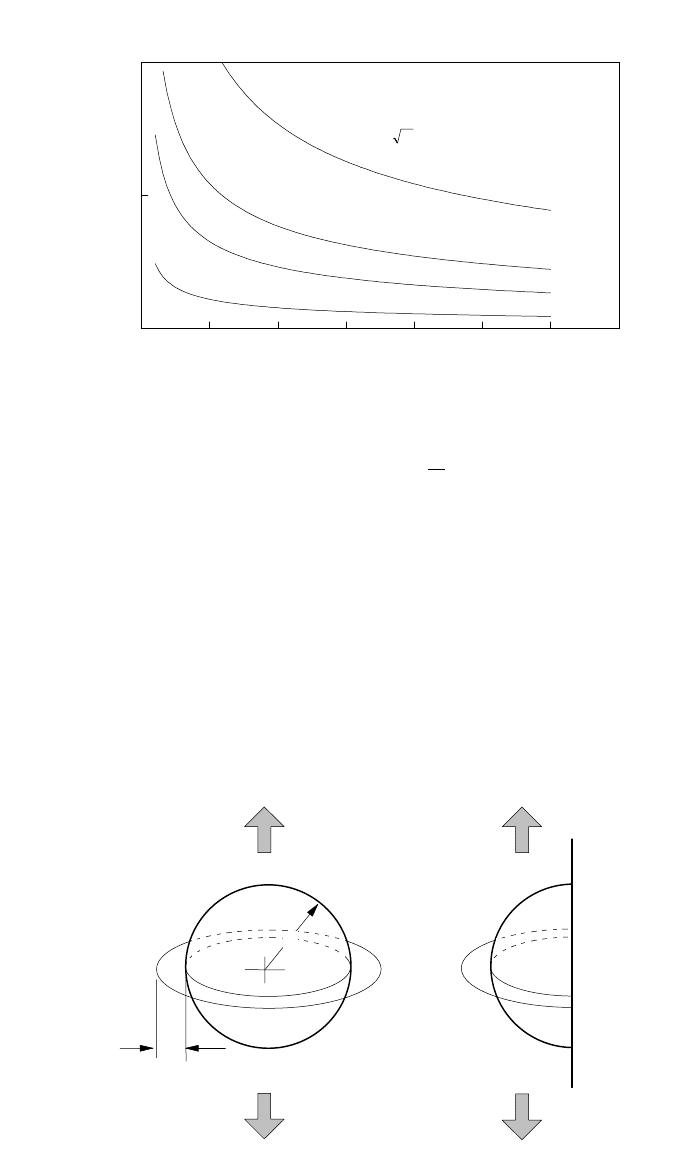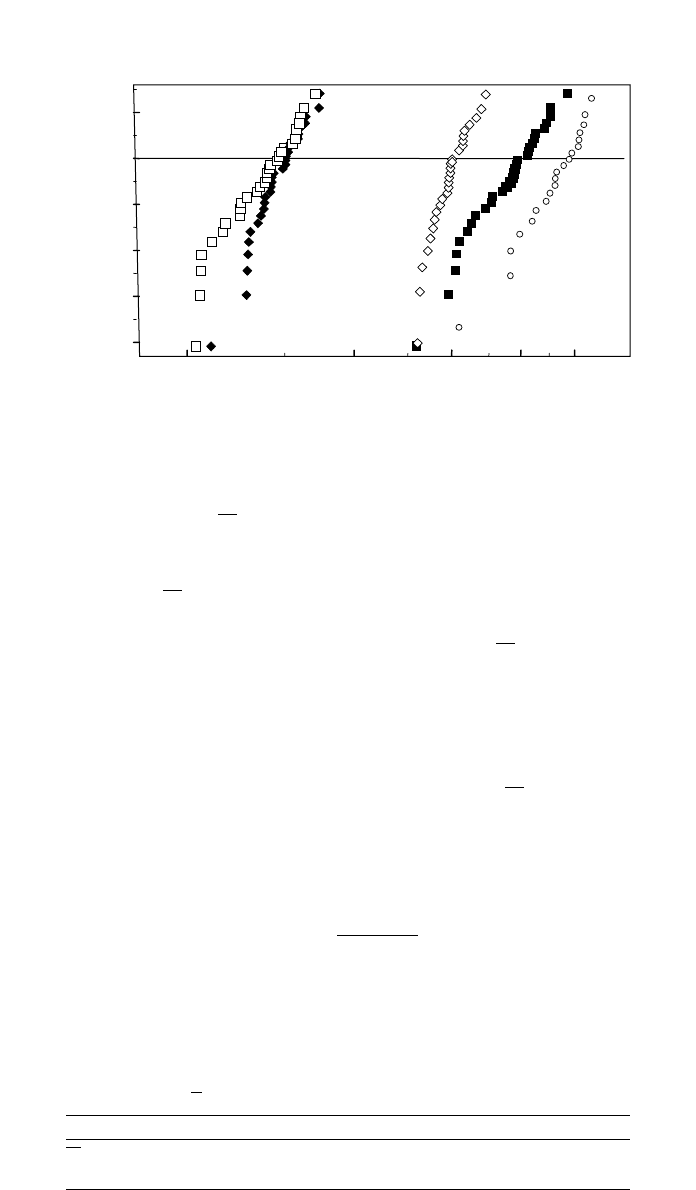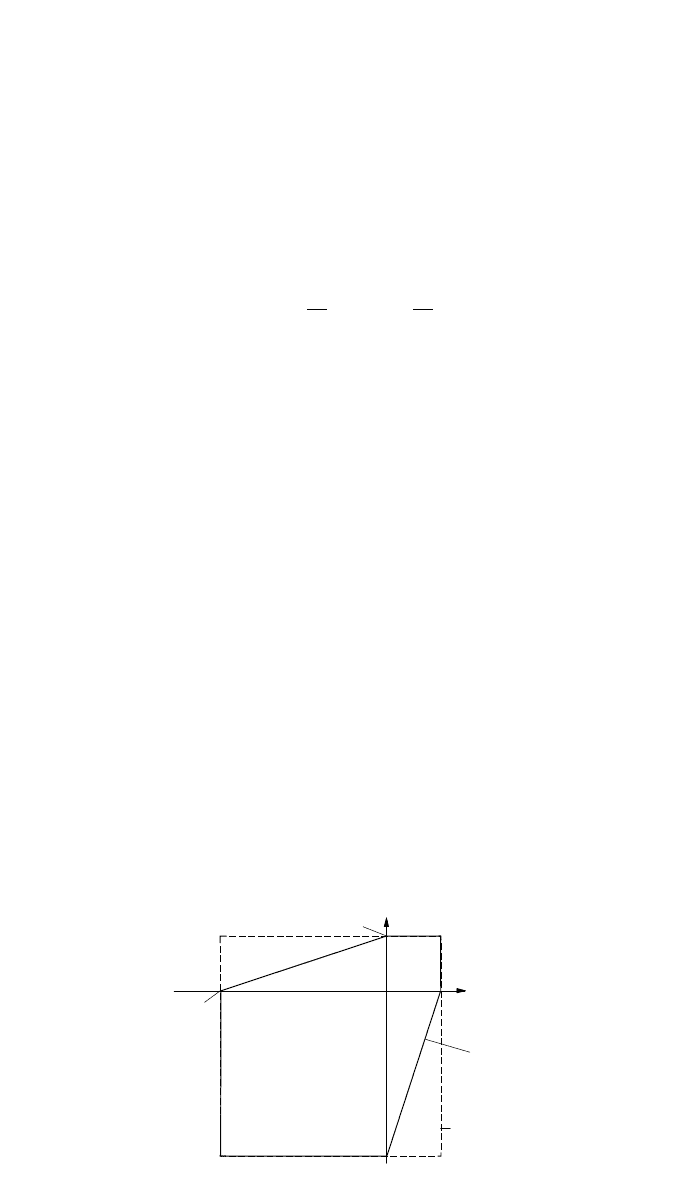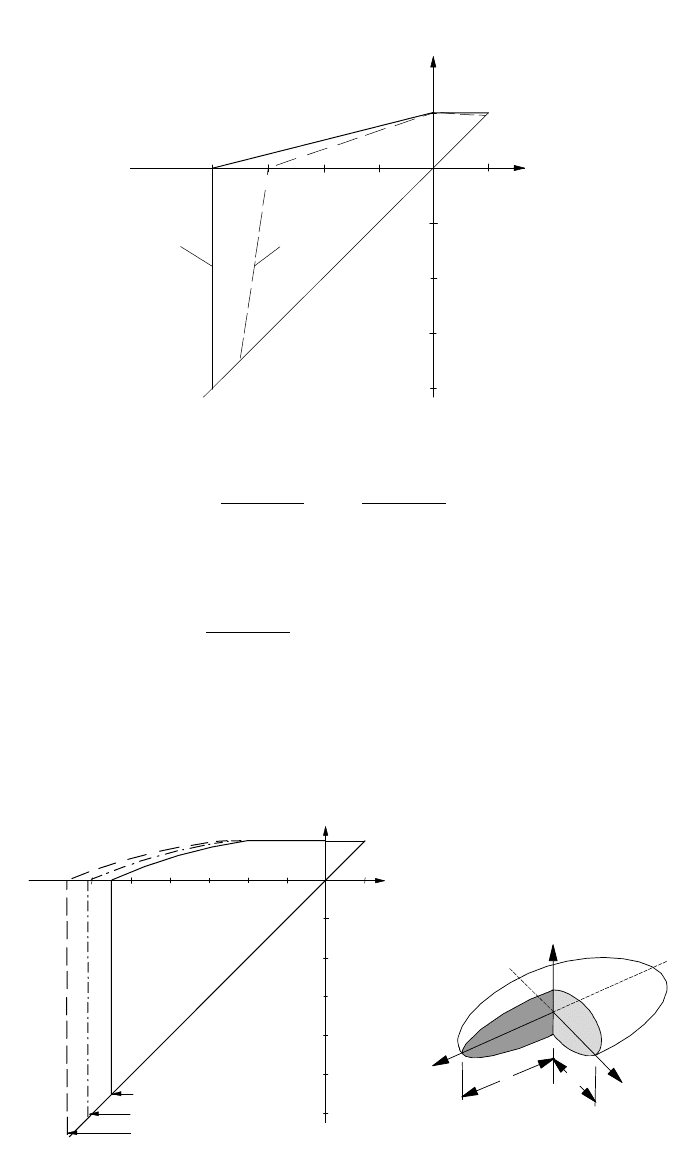Kutz M. Handbook of materials selection
Подождите немного. Документ загружается.


3 FRACTURE MECHANICS 791
0 0.1 0.2 0.3
0
500
1000
5
3
1
(
MPa
)
a
(
mm
)
mMPa10K
Ic
=
c
σ
Fig. 2 Strength as a function of flaw size for materials with different fracture toughness.
a)
b)
σ
z
R
a
σ
z
σ
z
σ
z
Fig. 3 Pores with annular crack.
of 781 MPa for a material with K
IC
⫽ 10 MPa (e.g., a zirconia). For a flaw兹m
size of 20
m the corresponding values are 873 and 1747 MPa. In view of this
large effect of the flaw size on the strength, a process technique that leads to a
reduction of the processing flaws is desirable. Fracture may also be caused by
surface flaws, introduced by grinding. Therefore, polishing the surface may also
increase the strength.
The type of flaws also affects the strength. Applying Eq. 1 requires the ex-
istence of a crack. Three-dimensional flaws such as pores are described as
spheres with a surrounding annular crack (Fig. 3). The stress intensity factor
then depends on the ratio of the size of the crack a to the radius of the sphere
R. The size of the crack may be in the order of the grain size.

792 FAILURE MODES
10
m=
1
2
50
100
equivalent crack len
g
th a , mm
1000
500
10
10
1
10
–4
–3
e
–2 –1
f
r
a
c
t
u
r
e
s
t
r
e
s
s
,
M
P
a
c
Fig. 4 Strength of silicon carbide vs. crack size. (From Ref. 1.)
4 STRENGTH
Equation 1 can be applied to predict the strength, if the crack size is known. In
metals this relation is used, for instance, to predict the remaining strength of a
component with a fatigue crack, whose size has been determined by a nonde-
structive testing method and is in the order of millimeters. In ceramic materials
the flaws are small in the order of 10–100
m and difficult to detect. Therefore
Eq. 1 has not yet been used to predict the strength or to reject components after
a nondestructive testing procedure. However, the relation shows the potential of
a material. A material with a high fracture toughness and a low strength may
have a potential for higher strength by a reduction in the flaw size.
In Fig. 4 the strength of SiC is plotted versus the crack size in a log-log plot.
For cracks larger than about 100
m a straight line with a slope of ⫺ is obtained
1
–
2
according to Eq. 1. For smaller cracks a deviation with an upper limit is ob-
served. The equivalent crack size is a length transformed to an internal crack in
a plate. The reasons for the deviation from Eq. 1 for small flaw sizes shall not
be discussed here.
Because of the large dependence of the strength on the flaw size for a given
material, the strength exhibits a large variation, depending on the processing
method of the material. Strength also can be varied for a given material by
varying the grain size and the microstructure in multiphase materials because
this may change the fracture toughness and the processing flaw size. The values
given in Table 1 are typical values of dense materials. Generally, the tensile
strengths of ceramics are lower than those of high-strength metals. Silicon nitride
and some zirconia materials, however, have strength values of up to 1000 MPa.
5 DELAYED FAILURE
Under cyclic loading, but also under constant loading, ceramic materials may
fail after some time. This is called static fatigue for constant loading and cyclic

5 DELAYED FAILURE 793
fatigue for cyclic loading. This designation contrasts with that in metals, where
the designation of fatigue is restricted to the damage under cyclic loading. The
failure behavior is described by an S–N curve, where the stress is plotted versus
the lifetime under static loading and the stress range
⌬
(twice the amplitude)
versus the number of cycles to failure under cyclic loading. In a log-log plot
straight lines are observed, which correspond to the relations:
A
t ⫽ (2a)
ƒ
n
A
N ⫽ (2b)
ƒ
n
(⌬
)
The phenomenon of delayed failure is caused by subcritical extension of the
flaws. For static loading the crack growth rate depends on the stress intensity
factor K and for cyclic loading on the range of the stress intensity factor
⌬K.In
a large range of crack growth rate, the subcritical crack extension can be de-
scribed by the relations of
da
n
⫽ CK (3a)
dt
da
n
⫽ C(⌬K) (3b)
dN
where da/dN is the crack extension for one load cycle. Equation 3 can be
obtained by integration of Eq. 4 from an initial crack size a
i
to a critical crack
size a
c
. Because of the high values of n, the critical crack size can be set to
infinity. The values of n in Eqs. 3 and 4 are the same for corresponding loading
situations (static or cyclic). The parameters A, C, and n are different for static
and cyclic loading, n
cyclic
being always somewhat smaller than n
static
. A and C for
cyclic loading depend on the mean stress, which conveniently is expressed by
the ratio of R
⫽
/
⫽ K /K .
min max min max
The following relation was found:
da C
n
⫽ (⌬K) (4)
n
⫺
p
dN (1 ⫺ R)
Integration leads to
n
⫺
p
(1 ⫺ R)) 1
N ⫽ C* ⫽ C* (5)
ƒ
npn
⫺
p
(⌬
)(⌬
)(
⫹ ⌬
/2)
m
Some values are given in Table 2. High values of n mean a large effect of the
stress or the stress range on the lifetime.

794 FAILURE MODES
Table 2 Some Values of n and p
2
Material nP
ZrO
2
(Y-TZP) 19 3
Si
3
N
4
29 1.3
SiC
w
/Al
2
O
3
10.2 4.8
Summary
●
Delayed failure is described by a power law relation between crack growth
rate and the stress intensity factor for constant loading and by a power
law relation between crack extension for one load cycle and the range of
the stress intensity factor for cyclic loading.
6 SCATTER OF STRENGTH AND LIFETIME
6.1 Scatter of Strength
Because of the statistical distribution of the flaw size, the strength is subjected
to considerable scatter. As a consequence, the design of ceramic components
cannot be based on an average strength and the application of a safety factor as
it is usually done for metallic components. The scatter is associated with an
effect of the size of a component and the stress distribution in the component
on the strength. Therefore, a statistical treatment of the scatter and a design
according to prescribed failure probability is necessary. In this section the
method of applying Weibull statistics to uniaxial loading is described. The design
applying multiaxial Weibull statistics will be presented in Section 7.
The scatter in the strength is described by the two-parameter Weibull distri-
bution. The failure probability, i.e., the probability of failure occurring below
the stress of
⫽
c
, is given by
m
c
F ⫽ 1 ⫺ exp ⫺ (6)
冋冉冊册
0
The Weibull parameter m is called the Weibull modulus and a measure of the
scatter. The Weibull parameter
0
is related to the strength. Whereas m is a
material parameter,
0
depends on the material, but also on the size of the
component and on the stress distribution in the component.
From Eq. 6 it follows that failure is possible also at very low stresses. There-
fore, a three-parameter Weibull distribution with a lower limit
u
is considered
sometimes:
m
⫺
cu
F ⫽ 1 ⫺ exp ⫺
⬎
(7)
冋冉 冊册
cu
0
It is, however, not possible to determine
u
with sufficient accuracy when ap-
plying a limited number of test specimens. Hence, the two-parameter distribution
is used usually.

6 SCATTER OF STRENGTH AND LIFETIME 795
Failure can be caused by surface flaws or volume flaws. For a homogeneous
stress distribution in a component and failure by volume flaws, Eq. 6 can be
replaced by
m
V
c
F ⫽ 1 ⫺ exp ⫺ (8)
冋冉冊册
V
0 V
where V is the volume and V
0
is the unit volume, which is introduced for nor-
malization. Now
V
is a quantity independent of the size of the component. An
inhomogeneous stress distribution in a component is described by the relation
of
(x, y, z) ⫽
*g(x, y, z) (9)
where
is a characteristic stress in the component and g(x, y, z) a geometry*
function. The failure probability then is given by
mm
V
1
*
*
eff
cc
m
F ⫽ 1 ⫺ exp ⫺ 冕gdV ⫽ 1 ⫺ exp ⫺ (10)
冋冉冊 册 冋冉冊册
V
V
0 V 0 V
where is the value of
at fracture and
**
c
m
V ⫽ 冕gdV (11)
eff
is the effective volume.
For surface flaws the volume in Eqs. 8–11 has to be replaced by the surface
area.
If Eq. 6 is used to calculate the failure probability for a component,
0,C
of
the component can be calculated from
0,SP
of the specimen by
1/m
V
eff, SP
⫽
(12)
冉冊
0,C 0,SP
V
eff,C
Experimental results are presented in a Weibull diagram, where ln ln 1/(1 ⫺
F) is plotted versus ln
c
. To correlate the measured strength values with the
failure probabilities, the strength values are ranked in increasing order and num-
bered from 1 to n. Then, the strength values
ci
are related to the failure prob-
ability F
i
according to
i
⫺ 0.5
F ⫽ (13)
i
n
The slope of the Weibull plot is m;
0
is the strength for F ⫽ 0.632. Examples
are shown in Fig. 5.

796 FAILURE MODES
200
400 600 800
1000
–4
–3
–2
–1
0
1
ZrO
2
ZTA
SSN
RBSN
Al
2
O
3
σ
c
(MPa)
ln ln (1/(1 – F))
Fig. 5 Weibull plots of strength for several materials (RBSN: reaction bonded silicon nitride,
SSN: sintered silicon nitride, ZTA: zirconia toughend alumina).
Table 3 Ratios
c
/
0
and
med
/
0
m ⫽ 5 m ⫽ 10 m ⫽ 20 m ⫽ 30 m ⫽ 50
/
0
c
0.918 0.951 0.974 0.982 0.989
med
/
0
0.929 0.964 0.982 0.988 0.993
The average strength and the median strength for
med
(
c
for F ⫽ 0.5)
c
are related to m and
0
by
1/m
⫽
⌫(1 ⫹ 1/m)
⫽ (0.693) (14)
c 0med
where ⌫ is the gamma function. In Table 3 the ratios /
0
and
med
/
0
are
c
given for different values of m.
Equations 8 and 10 lead to a large effect of the size of the component on the
strength, which depends on the Weibull modulus m. They also show a large
effect of m on the failure probability. This effect is illustrated in Fig. 6 by the
strength at different failure probabilities, Weibull parameters m, and different
effective volumes. For a material with a mean strength of
⫽ 500 MPa, which
c
was determined with four-point specimens having an inner span L ⫽ 20 mm,
width W
⫽ 4.5 mm, and height H ⫽ 3.5 mm. The effective volume of this
specimen is
LWH
V ⫽ (15)
eff
2(m ⫹ 1)
In Table 4 the parameter
0
and the effective volume are given for different
failure probabilities and different values of m.

6 SCATTER OF STRENGTH AND LIFETIME 797
0 102030405060
0
100
200
300
400
500
m
(MPa)
10
100
1000
10
100
1000
F=0.1
F=0.0001
3
eff
mm,V
c
σ
Fig. 6 Effect of Weibull modulus m and effective volume on the strength for two different fail-
ure probabilities for materials with the same average strength of 500 MPa.
Table 4 Strength at Different Failure Probabilities and Effective Volumes (Materials with
the Same Average Strength in Bending Tests)
mV
eff
(mm
3
)
0
F ⫽ 0.0001 F ⫽ 0.001 F ⫽ 0.01 F ⫽ 0.1 F ⫽ 0.5
510
100
1000
661
417
263
105
66
42
166
105
66
264
168
195
4222
266
168
615
388
245
10 10
100
1000
545
433
349
217
172
137
273
217
172
435
346
275
435
346
275
526
417
332
20 10
100
1000
506
451
402
319
284
253
358
319
284
402
358
319
452
403
359
496
442
394
50 10
100
1000
495
473
452
411
393
376
431
412
394
451
431
412
473
452
432
491
470
449
6.2 Scatter of Lifetime
The scatter of the lifetime under constant or cyclic loading is much larger than
that of the strength and can also described by a Weibull distribution. For static
fatigue the failure probability is
m
*
t
ƒ
F ⫽ 1 ⫺ exp ⫺ (16a)
冋冉冊册
t
0
and for cyclic fatigue
m
*
N
ƒ
F ⫽ 1 ⫺ exp ⫺ (16b)
冋冉冊册
N
0
If the strength and lifetime are caused by the same flaws, then the Weibull

798 FAILURE MODES
parameters m*, t
0
, and N
0
can be related to the Weibull parameters m and
0
of
the strength:
m
m* ⫽ (17)
n
⫺ 2
n
⫺
2
B
0
t ⫽ (18a)
0
n
n
⫺
2
B
0
N ⫽ (18b)
0
n
(⌬
)
where n is the crack growth exponent for static and cyclic crack extension,
respectively; B is given by
2
B ⫽ (19)
2 n
⫺
2
(n ⫺ 2)CY K
IC
with C from Eq. (4).
In Eq. 18
of the component has to be used. If
as obtained from the
0,C 0,SP
specimens is known, the parameters t
0
and N
0
in Eqs. 16 are
(n
⫺
2) / m
n
⫺
2
B
V
0,SP eff, SP
t ⫽ (20a)
冉冊
0,C
n
V
eff, C
(n
⫺
2) / m
n
⫺
2
B
V
0,SP eff, SP
N ⫽ (20b)
冉冊
0,C
n
(⌬
) V
eff, C
Summary
●
The scatter of the strength is described by the two-parameter Weibull
distribution with the Weibull modulus m.
●
The average strength and the strength at given failure probability depend
on the size of the component and the stress distribution in the component.
●
The lifetime is described by a Weibull distribution; the parameters can be
obtained from the Weibull parameters of the strength, if strength and life-
time are caused by the same flaws.
7 DESIGN APPLYING MULTIAXIAL WEIBULL STATISTICS
7.1 Strength Under Compression Loading
The strength of ceramic materials under compressive loading is much higher
than under tension loading. Usually compression tests are performed applying
cylindrical specimens. The cylinders are loaded with parallel stamps. Due to the
different lateral expansion of the specimen and the stamp under compressive
loading, radial stresses occur in the loaded specimen, which may lead to pre-
mature failure. The compressive strength measured therefore may depend on the
loading conditions. A detailed description of the compressive test is given in.
3
Some compressive strength results are presented in Table 1. The ratio between
compressive and tensile strength ranges between 2.5 and 18 depending on the

7 DESIGN APPLYING MULTIAXIAL WEIBULL STATISTICS 799
σ
1
σ
2
Mohr
modified
principal
stress
σ
cc
σ
ct
Fig. 7 Mohr’s hypothesis for biaxial loading.
material and the porosity. Dense materials have a higher ratio than porous ma-
terials.
7.2 Global Multiaxial Fracture Criterion
Whereas the strength of materials is measured under uniaxial tension or com-
pression loading, multiaxial stresses very often occur in components. This is the
case for uniaxial loading of notched components, for components under internal
pressure, or components under inhomogeneous temperature distribution. The de-
gree of multiaxiality is described by the ratios of
23
␣
⫽

⫽ (21)
11
where
1
,
2
, and
3
are the principal stresses. Two different approaches exist
to assess multiaxial stresses: A global multiaxiality and a local multiaxiality
criterion.
A global multiaxiality criterion is a relation between the principal stresses
and one or two material properties. The most reliable criterion is Mohr’s hy-
pothesis, which is presented here for a plane stress situation. It is based on the
tensile strength
ct
and compressive strength
cc
. The criterion is shown in Fig.
7 and reads
⫽
for
⬎ 0,
⬎ 0
1ct 1 2
⫽⫺
for
⬍ 0,
⬍ 0 (22)
2cc 1 2
⫽
(1 ⫹
/
) for
⬎ 0,
⬍ 0
1ct 2cc 1 2
7.3 Local Multiaxiality Criterion
The local multiaxiality criteria start with a flaw type that may be a pore or a
crack. The local fracture criterion is a critical tensile stress for a pore or a critical
stress intensity factor for a crack. Details can be found in Ref. 2. In the pore
models only the tensile strength appears as a material property. For a spherical
pore the failure relation is

800 FAILURE MODES
ν
=0.2
σ
1
/
σ
ct
1
–1–2
–3
–4
–2
–1
–3
σ
2
/
σ
ct
ν
=0.3
Fig. 8 Failure diagram for a spherical pore.
–1
–2
–3
–5
–4
–6
1
1
σ
1
/
σ
ct
–1
–2–3–4
–5
–6
b/a
ν
0.1 , 0.3
0.5 , 0.3
0.5 , 0.2
σ
2
/
σ
ct
x
y
z
ab
Fig. 9 Failure diagram for an elliptical pore. (From Ref. 2.)
15
⫺ 33⫹ 15
⫹
⫺
⫽
(23)
123ct
27 ⫺ 15
27 ⫺ 15
From this relation the compressive strength follows as
27
⫺ 15
4
, for
⫽ 0.2
ct
⫽
⫽ (24)
再
cc ct
3
, for
⫽ 0.3
3
⫹ 15
ct
Under triaxial compression, no failure is expected because the stresses at the
pore are negative. In Fig. 8 the failure diagram for plane stress is shown. Results
for an ellipsoidal pore are represented in Fig. 9. From these results it can be
